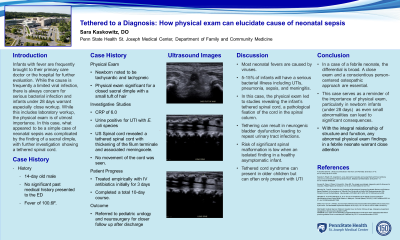Back

Clinical: General Topics
Tethered to the Diagnosis: How physical exam can elucidate cause of neonatal sepsis
Friday, March 31, 2023
12:00 PM East Coast USA Time

- SK
Sara Kaskowitz, DO (she/her/hers)
Penn State Health St. Joseph
Allentown, Pennsylvania, United States
Presenting Author(s)
Introduction: Infants with fever are frequently brought to their primary care doctor or the hospital for further evaluation. While the cause is frequently a limited viral infection, there is always concern for serious bacterial infection and infants under 28 days warrant especially close workup. While this includes laboratory workup, the physical exam is always of utmost importance. In this case, what appeared to be a simple case of neonatal sepsis was complicated by the finding of a sacral dimple, with further investigation showing a tethered spinal cord.
Case Study: A 14-day old male presented with a 100.6F fever with only associated tachycardia and tachypnea. Patient with a notably elevated CRP to 6.0 and urine positive for E. Coli UTI. He was found on exam to have a sacral dimple that deviated to the left without an obvious tract to the spinal cord. A subsequent US spinal cord revealed a tethered spinal cord and meningocele. This can be associated with urinary retention and subsequent UTI. He was treated empirically with IV antibiotics and ultimately completed a 10-day course. While it could not be definitively determined that patient’s UTI was secondary to his tethered spinal cord, he was referred to urology and neurosurgery for closer follow up.
Discussion: This case serves as a reminder of the importance of physical exam, particularly in newborn infants as even small abnormalities can lead to significant consequences. Although most neonatal fevers are caused by viruses, 5-15% of infants will have a serious bacterial illness including urinary tract infections, pneumonia, sepsis, and meningitis. In this case, the physical exam led to studies revealing the infant’s tethered spinal cord. Tethering of the spinal cord is a pathological fixation of the cord in the spinal column that can result in neurogenic bladder dysfunction leading to repeat urinary tract infections. As an isolated finding in an asymptomatic, healthy infant, the risk of a significant spinal malformation with a simple sacral dimple is considerably low. However, with the integral interrelationship of structure and function, any abnormal findings in a febrile neonate warrant close attention. In older children, tethered cord syndrome can present with gait abnormalities and pain, but often lower urinary tract dysfunction is the only sign. While none of these would be obviously apparent in a febrile neonate, it is clear that in a case with such a broad differential, a close exam and a conscientious person-centered osteopathic approach are key.
Case Study: A 14-day old male presented with a 100.6F fever with only associated tachycardia and tachypnea. Patient with a notably elevated CRP to 6.0 and urine positive for E. Coli UTI. He was found on exam to have a sacral dimple that deviated to the left without an obvious tract to the spinal cord. A subsequent US spinal cord revealed a tethered spinal cord and meningocele. This can be associated with urinary retention and subsequent UTI. He was treated empirically with IV antibiotics and ultimately completed a 10-day course. While it could not be definitively determined that patient’s UTI was secondary to his tethered spinal cord, he was referred to urology and neurosurgery for closer follow up.
Discussion: This case serves as a reminder of the importance of physical exam, particularly in newborn infants as even small abnormalities can lead to significant consequences. Although most neonatal fevers are caused by viruses, 5-15% of infants will have a serious bacterial illness including urinary tract infections, pneumonia, sepsis, and meningitis. In this case, the physical exam led to studies revealing the infant’s tethered spinal cord. Tethering of the spinal cord is a pathological fixation of the cord in the spinal column that can result in neurogenic bladder dysfunction leading to repeat urinary tract infections. As an isolated finding in an asymptomatic, healthy infant, the risk of a significant spinal malformation with a simple sacral dimple is considerably low. However, with the integral interrelationship of structure and function, any abnormal findings in a febrile neonate warrant close attention. In older children, tethered cord syndrome can present with gait abnormalities and pain, but often lower urinary tract dysfunction is the only sign. While none of these would be obviously apparent in a febrile neonate, it is clear that in a case with such a broad differential, a close exam and a conscientious person-centered osteopathic approach are key.
